Leicestershire contractor rates 70t Vervaet Quad XL slurry spreader
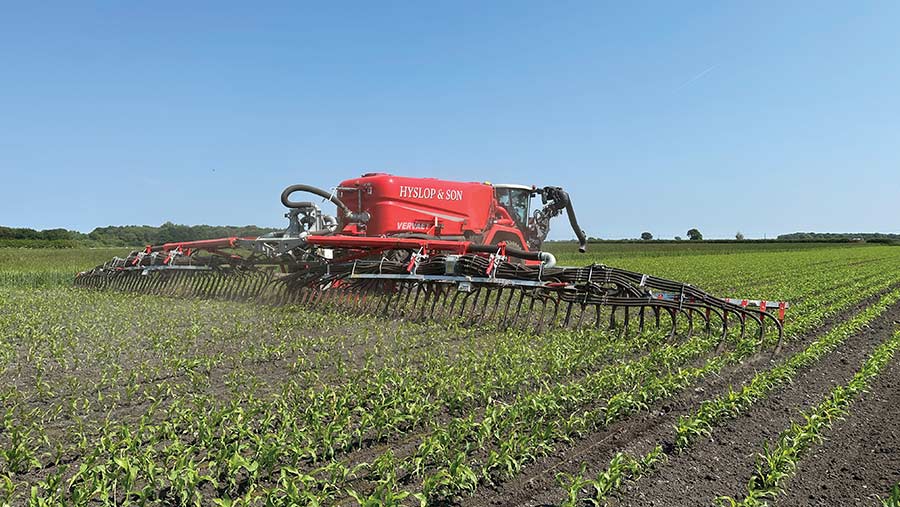 © Chris Lockwood
© Chris Lockwood Surging demand for cheaper crop nutrition in the face of last year’s volatile fertiliser prices drove farmers across the country to seek alternatives to synthetic nitrogen.
The resulting appetite for slurry and digestate has spawned a new self-propelled tanker combination, Vervaet’s Quad XL.
It sees the firm’s monster Quad 550 tractor unit paired with a second trailed vessel to provide a colossal 40cu m capacity.
The first of these behemoths to leave the factory wound up in Leicestershire – one at Prestons Agricultural Contractors at Desford, and the other to Mark and Rob Hyslop of R Hyslop & Son.
See also: Thompson Brothers’ bespoke umbilical slurry pumping trailer
The father-and-son team spread up to 400,000cu m of the brown stuff every year.
Business facts
R Hyslop & Son, Old Dalby, Leicestershire
- Slurry and digestate spreading Up to 400,000cu m/year, travelling across a 120-mile radius
- Muckspreading 120,000t of sewage sludge, compost and chicken muck
- Baling Up to 40,000 straw and 30,000 grass bales
The machine’s arrival marked the culmination of a rapid expansion in the slurry business for the Hyslops.
Having previously specialised in baling and forage production, they bought a single tractor-drawn tanker less than a decade ago.
They now count among their fleet two self-propelled applicators and nine Conor tankers to keep them busy, a brace of umbilical-fed dribble bars and a Joskin tanker and trailing shoe.
What’s in the shed?
- Tractors Fendt 724 x13, JCB Fastrac 4220, Massey Ferguson 7718
- Loaders JCB Loadall 536-95, one harvest hire, 419 loading shovel
- Digger JCB JS130
- Self-propelled spreaders Vervaet Quad 550 XL, Vredo VT4556
- Tankers Conor 18-21cu m x9, 18cu m Joskin with 12m Bomech trailing shoe
- Umbilical Remote-control pumps x2, Tramspread 12m dribblebar x2, Vogelsang 24m dribble bar, 4,000m pipe, Wox hose humpers x2
- Balers New Holland 1290 x4 (straw), New Holland 890 x2 (grass)
- Wrappers McHale 998 x2, Kuhn 4014
- Chasers Heath Super Chaser x2
- Muckspreaders Bunning Lowlander 175 HBD x2
- Hedgecutters Four McConnel and Shelbourne Reynolds 7m machines
- Staff 16 full-time, up to three sub-contractors with their own tractors
Versatile outfit
“Our first self-propelled machine, a 2020-built Vredo 4546 with 18m trailing shoe and 19cu m tank, was up for replacement and, after looking at the options, it was the Vervaet’s versatility that really appealed to us.”
With wide tramlines becoming the norm, the major attraction was the prospect of moving to a 36m dribble bar.
It also offered the option of detaching the rear tanker – leaving the Quad, when shod on twin-wheel row crops, to run solo with a 24m Vogelsang Blackbird applicator for maize applications.
“We’ve got a varied workload, half of which is on local dairy farms and the rest dealing with waste from AD plants and food factories, so we wanted the capacity to spread on tramlines at 36m, rather than having to put in 18m splits,” says Rob.
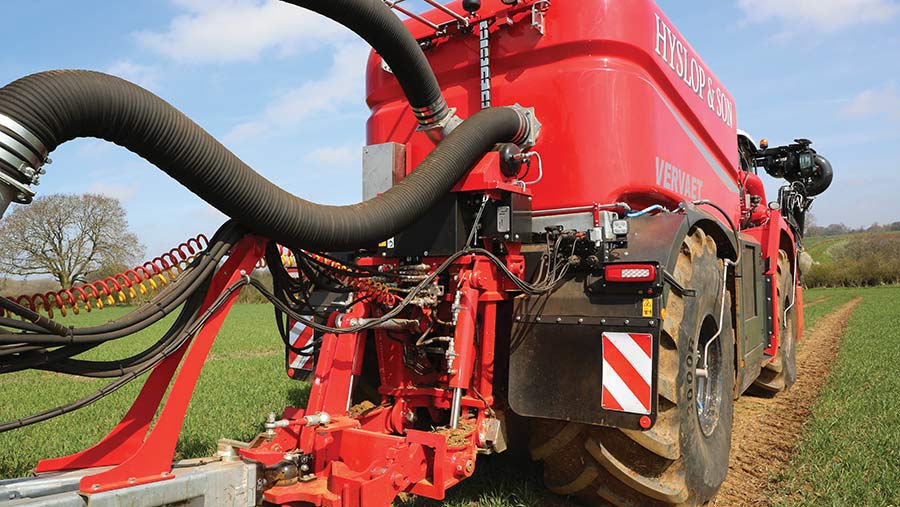
© Chris Lockwood
“This means we can extend our spreading window to later growth stages and we’re no longer restricted to only working on crops spaced at 75cm.
“We’re already seeing demand from customers that are drilling maize at 50cm centres.”
Most arable applications will be completed with the Quad 550 and tanker working in tandem.
In “auto” mode, this sees the front vessel emptied to 70%, at which point a transfer pump starts topping it up with slurry from the back – keeping most of the weight on the driven axles.
This combination is typically used from March until May, then again on pre-oilseed rape stubbles in August, accounting for roughly 40% (50,000cu m) of the Quad’s workload.
Heavy hauler
The Quad 550 has capacity for 22cu m in its piggyback tanker, with the trailed vessel adding another 18cu m.
That’s enough to comfortably swallow a 28cu m artic load – four of which are supplied by Lincolnshire contractor Ady Drewery during peak periods – without having to completely drain the tanks first.
Alternatively, it can squeeze in two 19cu m loads supplied by the Hyslops’ Conor tankers.
“The advantage is that we can refill when we’re at the right end of the field for loading, rather than having to fully empty and then stop part-way along a run,” says Rob.
“By taking bigger loads each time, a 400cu m field only requires 10 trips to a gateway or over-hedge loading point.
“That means we’re making less mess and it halves the amount of dead time running around compared with a 19cu m machine.
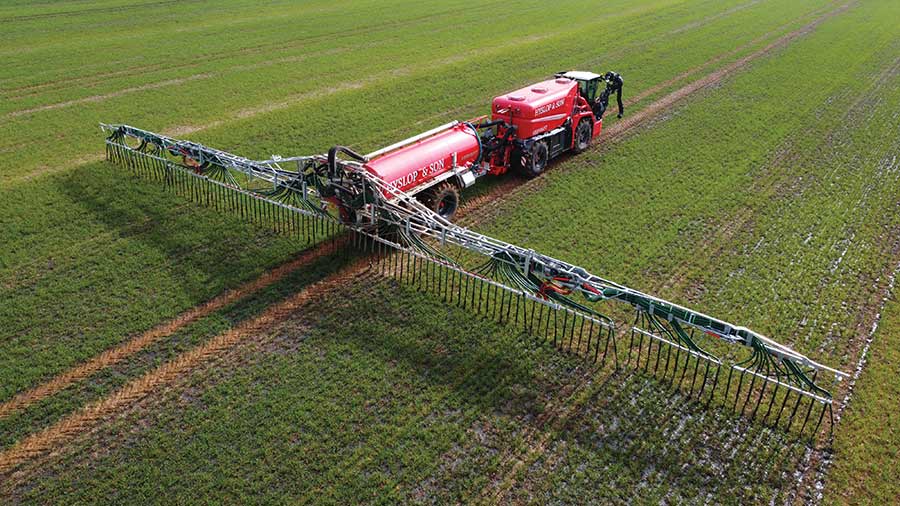
© Chris Lockwood
“It also gives us far greater flexibility in awkward-shaped fields where the machine might be working a long way from the gateway,” he adds.
Another improvement over its predecessor is the bigger 10in loading arm. The extra reach offers more loading options over hedges, so filling locations can be varied to minimise compaction at a single spot.
Any problems?
The Hyslops had three minor concerns about the new machine. The first was whether it would work first time, particularly given it was a brand-new design thrown straight into the busiest time of year.
“The development process was quick – ourselves and Prestons were invited to the Vervaet factory in autumn 2022 to discuss final designs, the deal was confirmed in December, and the machine was delivered in early April,” says Rob.
“We expected plenty of teething problems that only come to light once the machine is working, but J Riley’s backup has been the best we’ve ever known.
“They’ve made a few modifications overnight – predominantly software updates and tweaks to the pipe routing between the Quad and tanker – so we’ve had zero downtime.”
Apprehension over whether the tanker would neatly follow the Quad’s wheelings have also been put to rest, with the electronic potentiometer system, which works off the tractor unit’s rear axle, proving “faultless”.
And the biggest risk of all was whether the 70t loaded weight would rule out ever running at full capacity.
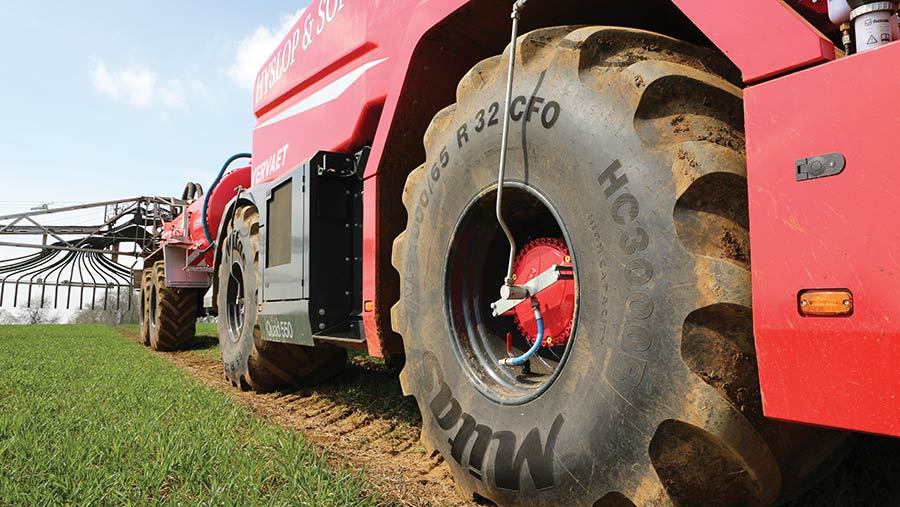
© Chris Lockwood
“Our first job was on an arable farm in wet conditions and on spongy ground, and it amazed us,” says Rob.
“We thought we’d end up putting 20-25cu m in at a time to minimise soil damage, but even with a full load it left just cleat marks in the tramlines.”
Part of that he attributes to decent weight balance, with roughly 30% of the tanker’s load carried on the Quad’s linkage mounted Scharmuller hitch.
But they also chose to spec it on bigger 1000/65 R32 Mitas VF tyres, rather than the standard 900s, which provide a huge rolling radius to spread the load over a bigger footprint.
Output
The Vervaet will take on the lion’s share of spreading, which should tally 120,000cu m this year over its expected 2,000 hours.
Application rates range from 20-40cu m/ha but, with the Quad’s pump tasked with feeding a huge quantity of material to the 36m dribble bar, average working speed is pegged at 6kph.
Guidance is provided by John Deere’s Greenstar SF1, and a Harvest Lab system transferred from the old Vredo monitors the nutrient value of the product being applied.
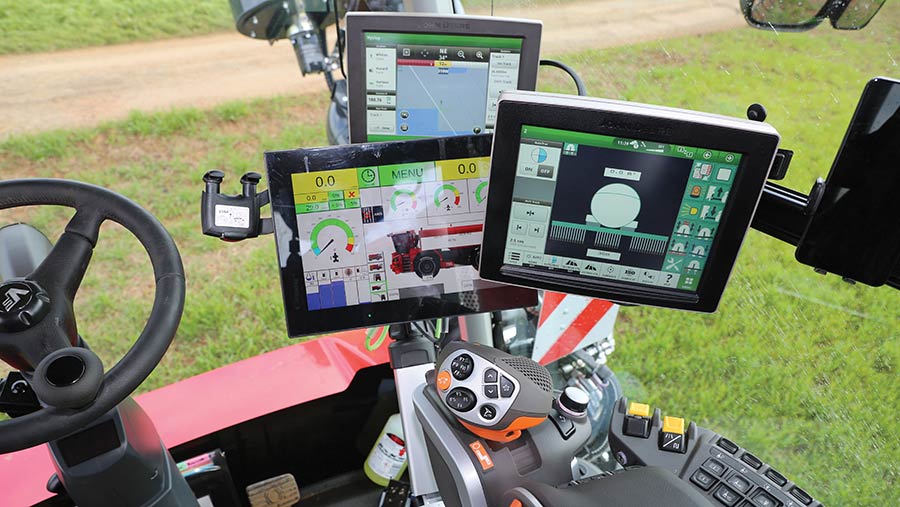
© Chris Lockwood
“It’s a guide rather than a bible, but all our customers – and, in particular, the arable farms taking digestate – are interested to know what they’re getting.
“That is only likely get more important with tighter legislation on the horizon,” says Rob.
“What the N sensor has brought to light is significant variations between lagoons and mixing systems, and it can be surprising to see how much the nutritional value fluctuates.
“We can tell customers that, for example, 80kg of available nitrogen has been applied, and they can then top this up with synthetic fertiliser to reach their requirements.”
Average output is roughly 1,300cu m/day, for which the Volvo Penta engine will drink about 600 litres. However, this is heavily influenced by ground conditions.
“When it’s hard and dry, an 800-litre tankful will be adequate to spread up to 1,800cu m, but that can drop to 1,200cu m when the going is soft and sticky.
“Either way, there’s plenty of power – the engine is practically on idle most of the time, to the point that it’s hard to tell whether you’ve got a full tank or an empty one,” he says.

